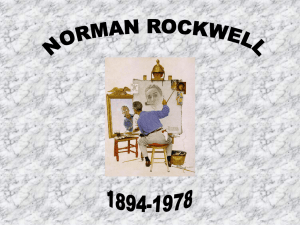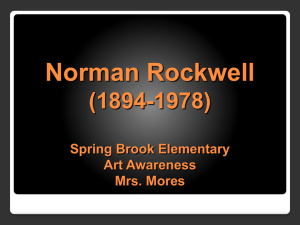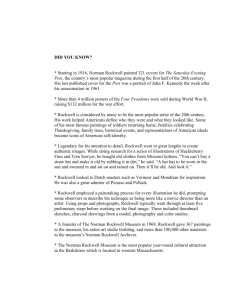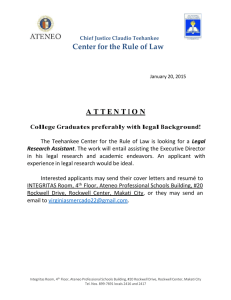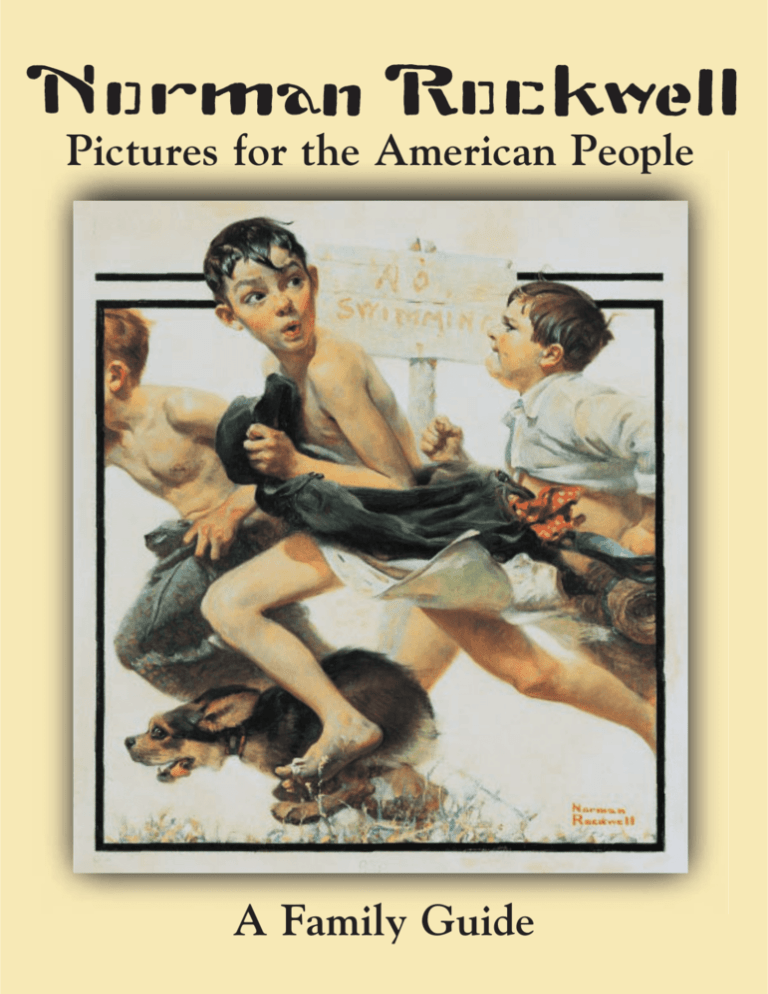
Pictures for the American People
A Family Guide
Norman Rockwell’s paintings...
Rockwell was born in New York City on February 3,
1894. When he was nine years old, his family moved
to the small town of Mamaroneck, New York. He was a
skinny boy and not very athletic, so he chose drawing
as his hobby. At age eighteen, Rockwell became art
editor of Boys’ Life, the official magazine of the Boy
Scouts of America. When Rockwell was twenty-two
years old, one of his paintings appeared on the cover of
The Saturday Evening Post, which showcased the works
of the finest illustrators of the period. Remarkably, in
forty-seven years, 321 of his paintings appeared on the
cover of the Post, making him one of the most famous
painters of the twentieth century.
Norman Rockwell created paintings to be enjoyed by
everyone. Many fine artists create paintings and
sculptures for private collectors, and sometimes this
artwork is not shown to the general public. Rockwell’s
paintings were seen across America, as they appeared
in books, advertisements, calendars, and on the covers
of popular magazines, such as The Saturday Evening
Post, Look, and Ladies’ Home Journal.
Are humorous:
Look at No Swimming on the
cover of this guide. Rockwell often paints the funniest
moment in a story. Rather than picture the boys
swimming in the forbidden pool, Rockwell paints the
moment when the rascals have been discovered and are
frantically trying to put their clothes back on as they
race from the scene of the crime.
Celebrate ordinary, everyday life:
Rockwell’s stories about swimming holes, gossiping,
family vacations, and barbershops are not what you read
about in newspaper headlines and history textbooks.
Rockwell painted scenes from the daily life of ordinary
people.
Are skillfully painted:
Rockwell carefully
studied the works of great artists like those pictured in
the upper right corner of the easel in Triple SelfPortrait. He also spent weeks, even months creating his
paintings.
LOOK
Look closely at the painting Triple
Self-Portrait. Can you find these items?
See page 15 for answers.
•
•
•
•
Rockwell often
included an image
of himself in his
paintings. Look for a
“Find Norman” symbol in
this family guide. When you see it,
search the painting for Rockwell’s
face. Remember sometimes he is
only a face in the crowd.
2
The “antique” that fooled Rockwell
The soft drink he often enjoyed as he worked
A reference to the accidental burning of his studio
A tribute to the great artists he admired
Triple Self-Portrait, 1960
The Saturday Evening Post
© 1960 The Curtis Publishing
Company
Many artists paint
pictures of themselves,
known as self-portraits.
When Rockwell painted
this self-portrait, he
included images of some
of his favorite artists
and shared details
about his life.
“It is no exaggeration to say simply that Norman
Rockwell is the most popular, the most loved, of all
contemporary artists...[H]e himself is like
a gallery of Rockwell paintings–friendly, human,
deeply American, varied in mood, but full,
always, of the zest of living.”
–Ben Hibbs, Saturday Evening Post Editor
TRY IT
Pretend you made a
visit to Rockwell’s studio. You two
hit it off quite well, and Rockwell
told you that, as a gift, he would like
you to select any item from this
painting. What would you bring
home and why? Draw a portrait of
yourself with your new treasure.
3
Rockwell The Artist
FUN FACT
Did you know
Rockwell left actual
globs of paint on
this canvas? Look
closely at the critic’s
palette. Each color
is a dried clump of
paint!
Art Critic, 1955, The Saturday Evening Post, © 1955 The Curtis Publishing Company
LOOK
Here is a finished painting entitled Art Critic. To the right is an early sketch.
How many differences can you find between the two versions? Can you think of any
reasons why Rockwell changed what he did?
4
Look more closely at some of Rockwell’s techniques.
Rockwell didn’t just sit down and begin to paint. Each painting was carefully
planned, and many took several months to complete.
• When he had an idea for a painting, Rockwell often took photographs of
models (sometimes his friends and neighbors) in various poses. A photo he
used to create Art Critic is shown at the right.
• He then mixed and matched details from these photos and made numerous
pencil sketches, rearranging the composition and adding new details.
• Rockwell sometimes coated the back of his final sketch with charcoal dust
and laid it on top of a canvas. By tracing the top image, he left a dust outline
on the canvas.
• He then painted on top of this sketchy image with oil paints, which covered
up the charcoal lines. Even while he was painting the picture, Rockwell often
made changes in the poses, the backgrounds, and facial expressions.
Photo by Gene Pelham
Photo by Bill Scovill
FUN FACT
The painting of the
woman in Art Critic
was based on photographs of Rockwell’s
wife, Mary.
5
Art Critic (study), 1955, © The Curtis Publishing Company
Rockwell The Humorist
6
The paintings on these two pages are called
sequence paintings because they are
composed of lots of little images that are
combined to tell a story, just like a comic
strip or a movie. The painting above is
entitled Day in the Life of a Little Girl.
Rockwell created another sequence painting
entitled Day in the Life of a Little Boy. Look
closely at this little girl’s day and try to
imagine what the boy’s day might look like.
Day in the Life of a Little Girl, 1952, The Saturday Evening Post
© 1952 The Curtis Publishing Company
TRY IT
Find a partner. Choose one of the images on
this page but don’t tell your partner which you chose. Simply
imitate the action and invite your partner to guess. Switch
and then guess as your partner imitates one of the images.
Remember, if you were a model for Norman Rockwell, you
might have to hold that pose for several minutes!
SEARCH
The people who posed for The Gossips were Rockwell’s neighbors in
Arlington, Vermont. His wife, Mary, appears in the painting, too. Look at her photograph on page 5 (posing for the painting Art Critic), then see if you can find her in the
painting below. The answer is on page 15. The models never knew how they would
look in the finished painting.
FUN FACT
The editor at The
Saturday Evening Post
did not believe that
anyone could have a
mouth as big as the
man with the black
hat. He said that no
one in America
would believe it.
Rockwell sent him a
photo of this man
with his mouth open,
and the editor had to
agree–that man had
one enormous mouth!
So the painting was
published exactly how
Rockwell painted it.
The Gossips, 1948, The Saturday Evening Post
© 1948 The Curtis Publishing Company
TRY IT
Write dialogue for the people in the
painting. Why is the woman at the end shocked?
Do you think the story the woman tells in the
beginning has changed by the end?
Why are some of the folks laughing?
7
Inventing America
America went through many changes during Rockwell’s sixty-year career. He often
illustrated these transitions from an old way of life to a new future by combining
something traditional with something modern. Today, these paintings help us imagine
what it must have been like to live in earlier times.
In the painting Going
and Coming, Rockwell
shows an old-fashioned
tradition: family gatherings. This family,
however, is wrapped in
a modern invention:
the American station
wagon.
LOOK
Notice
the feelings Rockwell
shows in the top part
of the painting. How
are the two parts the
same, how are they
different? Look for the
one person who
remains unchanged.
Going and Coming, 1947
The Saturday Evening Post
© 1947 The Curtis Publishing Company
During the 1940s and 1950s, a
feeling of hopeful idealism could
be found in a number of movies
and television shows, such as It’s
a Wonderful Life or Leave It To
Beaver. Like many Rockwell
paintings, these shows depicted
life in an idealized American
home.
8
• Can you think of a TV show or movie about average
people doing ordinary things in a small town?
• If you were to write a story or make a movie, would
it resemble your own life, or would it be a fantasy of
your imagining?
• Can you think of any changes that have taken place
in our world since your parents were your age?
FUN FACT
Rockwell said if he
were to paint this
work again, he
would leave out
the magazine.
How would this
change the
meaning of the
painting?
Girl at Mirror, 1954
The Saturday Evening Post
© 1954 The Curtis Publishing
Company
Rockwell remembers thinking about growing up when he was a child. He was a bit concerned about
not always fitting in with the other kids, “When I got to be ten or eleven…I could see I wasn’t God’s
gift to man in general or to the baseball coach in particular….At the age boys who are athletes were
expressing themselves fully….I didn’t have that. All I had was my ability to draw.”
LOOK
This painting captures a change from an old way of life
to a new way. See how the girl is in a room surrounded with oldfashioned things–her doll, the chair, her clothing. They all relate to
the past. She is looking in a mirror thinking about growing up,
and the comfortable old things around her may be Rockwell’s way
of suggesting that the old-fashioned values and traditions of the
past will help her as she moves into the future.
SEARCH
The little girl in this
painting is Mary Whalen Leonard, who
Rockwell met at a basketball game.
Rockwell often used her as a model
because he found she could act out “any
story.” Look through the family guide to
find another painting in which you can
find her acting out several stories.
9
Honoring the
American Spirit
When the United States entered World War II in
December 1941, Rockwell wanted to help in the war
effort. Remembering a speech President Franklin D.
Roosevelt had made earlier in the year, Rockwell
painted pictures to help people better understand the
four basic freedoms the president thought everyone in
the world should have: freedom of speech, freedom to
worship, freedom from want, and freedom from fear.
It took Rockwell seven months to complete the four
paintings. He painted Freedom of Speech and Freedom
to Worship several times before he was satisfied with
the results. In the middle of the night when pondering how to best depict freedom of speech, Rockwell
was struck with what he called “the best idea I’d ever
had.” He remembered a man who stood up at a town
meeting and made a comment. Everyone disagreed
with him but believed that he had the right to speak
his mind. This, Rockwell thought, was what freedom
of speech was all about.
Freedom of Speech, 1943, The Saturday Evening Post
© 1943 The Curtis Publishing Company
FUN FACT
Rockwell claimed
that the turkey featured in Freedom
from Want was, in fact, the Rockwell
family’s Thanksgiving turkey. He later
confessed, “This was one
of the few times I’ve
ever eaten the
model.”
SEARCH
Rockwell used many of his friends
and family in this painting. The woman serving the
Thanksgiving turkey in Freedom from Want was the
Rockwell family cook, and he also included his wife,
Mary. Look closely to find her.
10
Freedom from Want, 1943, The Saturday Evening Post
© 1943 The Curtis Publishing Company
SEARCH
The father in Freedom from Fear
appears in all four paintings. Can you find him?
FUN FACT
The American people
responded enthusiastically to
The Four Freedoms. After the
paintings appeared in The
Saturday Evening Post, 70,000
people wrote letters of praise
to the magazine. That’s a
stack of letters over six
basketball goals high!
Freedom from Fear, 1943
The Saturday Evening Post
© 1943 The Curtis Publishing Company
LOOK
Rockwell was able to
convey complicated ideas without
using words. By looking at the
details of a painting–the clothing
people wear, the expressions on their
faces–we discover things about them
that would take pages of text to
explain.
TRY IT
Pick a person from
one of The Four Freedoms and
describe everything you can about
his or her life just by the details
Rockwell has painted.
SEARCH
The woman with
a braid in her hair in Freedom to
Worship also appears in another
painting in this guide. Can you find
her?
Freedom to Worship, 1943, The Saturday Evening Post
© 1943 The Curtis Publishing Company
11
Honoring the
American Spirit
“Like everyone else, I'm concerned with the world
situation, and like everyone else, I'd like to
contribute something to help.”
–Norman Rockwell
Throughout his life,
Rockwell was concerned
with political issues, such
as racism, poverty, and
social injustice. In the
1960s, Rockwell painted
for Look magazine. These
illustrations addressed
important events of the
day and were generally
less humorous than those
he painted for The
Saturday Evening Post.
FUN FACT
During his life,
Rockwell traveled to
many countries in
Europe, as well as
India, Egypt, Iran,
and Turkey.
LOOK
Rockwell used photos of his friends
and neighbors in Vermont and Massachusetts
to compose the painting Golden Rule. What
similarities do you see between these individuals? Notice he shows two different women
holding babies. Why do you think he put two
people in almost the same pose at the center of
the painting?
12
Golden Rule, 1961, The Saturday Evening Post
© 1961 The Curtis Publishing Company
When Rockwell painted New Kids in the
Neighborhood, America was experiencing the
civil rights movement. Families from different
cultures and backgrounds were beginning to
live in the same neighborhoods, eat at the same
restaurants, and sit next to each other on buses.
New Kids in the Neighborhood, 1967, Look
© 1967 The Norman Rockwell
Estate Licensing Company
LOOK
The two groups of children in New
Kids in the Neighborhood may look different, but
they also have several things in common. Can
you find them? When the kids start to talk and
play together, what do you think they will find?
13
Celebrating the
Commonplace
“Commonplaces are never tiresome.
It is we who become tired when we cease to be curious
or appreciative...[We] find that it is not a new scene
which is needed, but a new viewpoint.”
–Norman Rockwell
Rockwell liked to focus
on the lives of ordinary
people in typical
American towns,
enjoying the simple
pleasures of life.
These images proved
very popular with
Saturday Evening Post
readers. They felt that
they were seeing
themselves on the
cover of a magazine!
TRY IT
In this painting,
Rockwell carefully created a
composition out of rectangles.
With a dark marker, outline the
rectangles you can see. Notice
how Rockwell built his painting
around these shapes.
Shuffleton’s Barbershop, 1950
The Saturday Evening Post
© 1950 The Curtis Publishing Company
LOOK
When looking at the painting Shuffleton’s Barbershop, what
is your viewpoint? Where are you standing as you look in on this scene?
What kinds of clues can you find about the shop?
Who might work there? What other hobbies do they have?
Who are the people inside, and how long have they known each other?
Can you think of a tune they might be playing? What other
instruments might be in the group hidden from our view?
14
Rockwell gives us lots of clues to help us understand the story he’s
telling. Sometimes he leaves things hidden so we can imagine
stories of our own.
Norman Rockwell: Pictures for the American People
is organized by The Norman Rockwell Museum at Stockbridge
and the High Museum of Art, Atlanta.
The exhibition and its national tour are made possible by Ford Motor Company.
The exhibition and its accompanying catalogue are also made possible by The Henry Luce Foundation.
Additional support is provided by The Curtis Publishing Company and
The Norman Rockwell Estate Licensing Company.
Education programs for the national tour are made possible by
Fidelity Investments through the Fidelity Foundation.
In Atlanta, the exhibition is made possible by The Fraser-Parker Foundation.
No Swimming, 1921, The Saturday Evening Post
© 1921 The Curtis Publishing Company
Page 7 Mary is the second person from the left
in the third row.
The pictures pinned to
Rockwell’s canvas are selfportraits by Albrecht
Dürer, Rembrandt, Pablo
Picasso, and Vincent van
Gogh.
ON THE COVER
WORD SEARCH
self-portrait
Norman
Rockwell
sequence
traditional
modern
magazine
golden rule
T
R
E
D
B
E
C
N
E
U
Q
E
S
D
N
S
M
O
D
E
E
R
F
E
G
P
H
L
A
C
I
T
I
L
O
P
I
E
D
E
A
R
O
T
A
R
T
S
U
L
L
I
N
O
P
M
T
E
R
B
P
E
L
S
H
R
I
I
O
H
U
M
O
R
O
U
S
O
freedoms
photograph
models
American
E
T
H
N
A
M
R
O
N
H
R
E
T
D
I
S
P
W
T
E
P
A
I
N
T
O
O
D
O
L
R
A
I
C
I
L
E
C
G
political
illustrator
humorous
commonplace
M
A
G
A
Z
I
N
E
T
R
D
H
R
E
R
I
C
H
A
M
O
D
E
L
S
A
E
T
H
E
L
L
E
W
K
C
O
R
P
D
E
A
M
E
R
I
C
A
N
G
Y
H
15
Page 11 Rose Hoyt also
appears in Golden Rule.
Page 10 (Find Norman)
Only a portion of
Rockwell’s face can be
seen. His eye is visible
on the left edge of the
painting, looking at the
man speaking.
Page 10 Mary Rockwell
is sitting on the left of
the table, and Rockwell’s
mother is on the right.
The smoke rising from
the trash can is a reference to the accidental
burning of Rockwell’s studio in 1943.
Page 9 She also was the
model for Day in the Life
of a Little Girl on page 6.
Norman Rockwell’s daily
cola drink is precariously
perched on his art book.
Page 7 (Find Norman)
Rockwell appears in the
last row, pointing at the
woman. He was the
subject of the
gossip.
Page 2 The gold helmet
atop the easel: Rockwell
thought it was an antique
army helmet but later
discovered it was just a
fireman’s hat!
ANSWERS
TRY IT
Make your own Saturday Evening Post cover using Rockwell’s technique (see pages
4-5 for ideas). Think of something you want to celebrate about your life, your town, or your
neighborhood. Sketch all the different ideas you have, then select the very best one. Using a
sharp pencil, lightly trace the outlines of the image in the box provided. Add more details by
tracing from different images. When you are finished, use crayons or paint to color in the image.
Resources Menu | Coffee | Library | Gallery | Lucidcafé Home | Revised: January 1, 2011
Norman Rockwell
American Illustrator and Painter
1894 - 1978
I showed the America I knew and observed
to others who might not have noticed.
—Norman Rockwell
Norman Percevel Rockwell was born on February 3, 1894, the second son of Nancy and Waring Rockwell. He and his brother Jarvis lived in
New York City until Norman was 9 years old at which point they moved to the suburban commuter town of Mamaroneck. Norman left high
school early to return to New York City, settling at the Arts Student League to study art where his discipline, hard work, and sense of humor
were widely recognized. As a student Norman was given small illustration jobs, but his major breakthrough came in 1912 with his first book
illustration for C.H. Claudy's Tell Me Why: Stories about Mother Nature. By 1913 he was art editor for Boy's Life and just 19 years old.
Considered a modest, retiring man, not given to grand gestures, Norman impressed himself on America's collective imagination by his stubborn
adherence to the old values. His ability to relate these values to the events and circumstances of a rapidly changing world made him a special
person—both hero and friend—to millions of his compatriots.
It has often been said that Norman provided a commodity that people could rely on. This is clearly reflected in more than 4,000 illustrations
completed throughout his 47 year career. He is best known for his contributions to the Saturday Evening Post for whom he produced 332
covers, beginning in 1916. It is noteworthy that the Post could automatically increase its print order by 250,000 copies when an issue had a
cover by Rockwell.
Eighty magazines used his cover illustrations but, by far, no paintings by an American were ever published on such a global scale as Rockwell's
"Four Freedoms." First appearing in the Post, the originals were used by the United States Treasury in a 16 city tour seen by 1,222,000 people
who purchased over $133,000,000 in war bonds.
Norman's ability to "get the point across" in one picture, and his flair for painstaking detail made him a favorite of the advertising industry. He
was also commissioned to illustrate over 40 books including the ever popular Adventures of Tom Sawyer and Huckleberry Finn. His annual
contributions for the Boy Scout calendars (1925 - 1976), was only slightly overshadowed by his most popular of calendar works - the "Four
Seasons" illustrations for Brown & Bigelow were published for 17 years beginning in 1947 and reproduced in various styles and sizes since
1964. Illustrations for booklets, catalogs, posters (particularly movie promotions), sheet music, stamps, playing cards, and murals (including
Yankee Doodle Dandy, was completed in 1936 for the Nassau Inn in Princeton, New Jersey) rounded out Rockwell's oeuvre as an illustrator. In
his later years, Rockwell began receiving more attention as a painter when he chose more serious subjects such as the series on racism for
Look magazine.
Christopher Finch, author and art curator, had this to say: "Norman Rockwell created a world that, because of its traditional elements, seems
familiar to all of us, yet is recognizably his and his alone. He is an American original who left his mark not by effecting radical change but rather
by giving old subjects his own, inimitable inflection. His career has been an ode to the ordinary, a triumph of common sense and
understatement."
Rockwell made no secret of his lifetime preference for countrified realism . . . "Things happen in the country, but you don't see them. In the city
you are constantly confronted by unpleasantness. I find it sordid and unsettling." His time spent in the country was a great influence on his
idyllic approach to storytelling on canvas. From 1953 until his death in 1978, Norman lived at Stockbridge, Massachusetts, where there is a
museum devoted to him.
Although Norman Rockwell was always at odds with contemporary notions of what an artist should be, he chose to paint life as he wanted to
see it. His themes and unique style have passed the test of time making him the best known of all American artists.
If you are aware of any Internet resources, films or books about Norman Rockwell or related subjects, or if you would like to submit comments,
please send us email: rc@lucidcafe.com.
Resources
From Wikipedia, the free encyclopedia
Norman Percevel Rockwell (February 3, 1894 – November 8, 1978)
was a 20th-century American painter and illustrator. His works enjoy a
broad popular appeal in the United States, where Rockwell is most
famous for the cover illustrations of everyday life scenarios he created
for The Saturday Evening Post magazine for more than four decades.[1]
Among the best-known of Rockwell's works are the Willie Gillis series,
Rosie the Riveter (although his Rosie was reproduced less than others of
the day), Saying Grace (1951), The Problem We All Live With, and the
Four Freedoms series. He is also noted for his work for the Boy Scouts
of America (BSA); producing covers for their publication Boys' Life,
calendars, and other illustrations.
1 Life and works
1.1 Early life
1.2 World War I
1.3 Personal life
1.4 World War II
1.5 Later career
2 Body of work
2.1 Influence
3 List of major works
4 Gallery
5 See also
6 References
7 Further reading
8 External links
Norman Rockwell
Birth name
Norman Percevel Rockwell
Born
February 3, 1894
New York City, New York
Died
November 8, 1978 (aged 84)
Stockbridge, Massachusetts
Nationality
United States
Field
Painting, illustrator
Training
National Academy of Design
Art Students League
Works
Willie Gillis
Saying Grace
Four Freedoms
Early life
Norman Rockwell was born on February 3, 1894, in New York City to Jarvis Waring Rockwell and Anne Mary "Nancy"
(née Hill) Rockwell.[2][3][4] His earliest American ancestor was John Rockwell (1588–1662), from Somerset, England, who
immigrated to America probably in 1635 aboard the ship Hopewell and became one of the first settlers of Windsor,
Connecticut.[5] He had one brother, Jarvis Waring Rockwell, Jr., older by a year and half.[6][7] Jarvis Waring, Sr., was the
manager of the New York office of a Philadelphia textile firm, George Wood, Sons & Company, where he spent his entire
career.[6][8][9]
Norman transferred from high school to the Chase Art School at the age of 14. He then went on to the National Academy
of Design and finally to the Art Students League. There, he was taught by Thomas Fogarty, George Bridgman, and Frank
Vincent DuMond; his early works were produced for St. Nicholas Magazine, the Boy Scouts of America (BSA) publication
Boys' Life and other juvenile publications. Joseph Csatari carried on his legacy and style for the BSA.
As a student, Rockwell was given smaller, less important jobs. His first major breakthrough came in 1912 at age eighteen
with his first book illustration for Carl Harry Claudy's Tell Me Why: Stories about Mother Nature.
In 1913, the nineteen-year old Rockwell became the art editor for Boys' Life, published by the Boy Scouts of America, a
post he held for three years (1913–1916).[10] As part of that position, he painted several covers, beginning with his first
published magazine cover, Scout at Ship's Wheel, appearing on the Boys' Life September 1913 edition.
World War I
During the First World War, he tried to enlist into the U.S. Navy but was refused entry
because, at 6 feet (1.83 m) tall and 140 pounds (64 kg), he was eight pounds underweight.
To compensate, he spent one night gorging himself on bananas, liquids and doughnuts, and
weighed enough to enlist the next day. However, he was given the role of a military artist
and did not see any action during his tour of duty.
Rockwell's family moved to New Rochelle, New York when
Norman was 21 years old and shared a studio with the
cartoonist Clyde Forsythe, who worked for The Saturday
Evening Post. With Forsythe's help, he submitted his first
successful cover painting to the Post in 1916, Mother's Day
Off
(published on May 20). He followed that success with
Scout at Ship's Wheel, 1913
Circus Barker and Strongman (published on June 3), Gramps
at the Plate (August 5), Redhead Loves Hatty Perkins
(September 16), People in a Theatre Balcony (October 14) and Man Playing Santa
(December 9). Rockwell was published eight times total on the Post cover within the first
twelve months. Norman Rockwell published a total of 322 original covers for The Saturday
Evening Post over 47 years. His Sharp Harmony appeared on the cover of the issue dated
September 26, 1936; depicts a barber and three clients, enjoying an a cappella song. The image
was adopted by SPEBSQSA in its promotion of the art.
The Four
Freedoms:Freedom of
Speech
Rockwell's success on the cover of the Post led to covers for other magazines of the day, most
notably The Literary Digest, The Country Gentleman, Leslie's Weekly, Judge, Peoples
Popular Monthly and Life Magazine.
Personal life
Rockwell married his first wife, Irene O'Connor, in 1916. Irene was Rockwell's model in
Mother Tucking Children into Bed, published on the cover of The Literary Digest on January
19, 1921. However, the couple were divorced in 1930. Depressed, he moved briefly to
Alhambra, California as a guest of his old friend Clyde Forsythe. There he painted some of his
best-known paintings including "The Doctor and the Doll". While there he met and married
schoolteacher Mary Barstow.[11] The couple returned to New York shortly after their marriage.
They had three children: Jarvis Waring, Thomas Rhodes and Peter Barstow. The family lived at
24 Lord Kitchener Road in the Bonnie Crest neighborhood of New Rochelle, New York.
Rockwell and his wife were not very religious, although they were members of St. John's
Wilmot Church, an Episcopal church near their home, and had their sons baptized there as
well. Rockwell moved to Arlington, Vermont, in 1939 where his work began to reflect
small-town life.[citation needed]
The Four
Freedoms:Freedom from
Want
In 1953, the Rockwell family moved to Stockbridge, Massachusetts, so that his wife could be treated at the Austen Riggs
Center, a psychiatric hospital at 25 Main Street, down Main Street from where Rockwell set up his studio.[12] Rockwell
himself received psychiatric treatment from the renowned analyst Erik Erikson, who was on staff at Riggs. Erikson is said
to have told the artist that he painted his happiness, but did not live it.[13] In 1959, Mary Barstow Rockwell died
unexpectedly of a heart attack. In 1961, Rockwell married Molly Punderson, a retired teacher.
World War II
The rear of Norman Rockwell's
preserved studio.
In 1943, during the Second World War, Rockwell painted the Four Freedoms series,
which was completed in seven months and resulted in his losing 15 pounds. The
series was inspired by a speech (http://www.americanrhetoric.com/speeches
/fdrthefourfreedoms.htm) by Franklin D. Roosevelt, in which he described four
principles for universal rights: Freedom from Want, Freedom of Speech, Freedom to
Worship, and Freedom from Fear. The paintings were published in 1943 by The
Saturday Evening Post. The United States Department of the Treasury later
promoted war bonds by exhibiting the originals in 16 cities. Rockwell himself
considered "Freedom of Speech" to be the best of the four. That same year a fire in
his studio destroyed numerous original paintings, costumes, and props.
Shortly after the war, Rockwell was contacted by writer Elliott Caplin, brother of
cartoonist Al Capp, with the suggestion that the three of them should make a daily
comic strip together, with Caplin and his brother writing and Rockwell drawing. King Features Syndicate is reported to
have promised a $1,000/week deal, knowing that a Capp-Rockwell collaboration would gain strong public interest.
However, the project was ultimately aborted as it turned out that Rockwell, known for his perfectionism as an artist, could
not deliver material as fast as required of him for a daily comic strip.[14]
During the late 1940s, Norman Rockwell spent the winter months as artist-in-residence at Otis College of Art and Design.
Students occasionally were models for his Saturday Evening Post covers. In 1949, Rockwell donated an original Post cover,
"April Fool," to be raffled off in a library fund raiser.
In 1959, his wife Mary died unexpectedly, and Rockwell took time off from his work to grieve. It was during this break that
he and his son Thomas produced his autobiography, My Adventures as an Illustrator, which was published in 1960. The
Post printed excerpts from this book in eight consecutive issues, the first containing Rockwell's famous Triple
Self-Portrait.
Later career
Rockwell married his third wife, retired Milton Academy English teacher, Molly Punderson,
in 1961. His last painting for the Post was published in 1963, marking the end of a
publishing relationship that had included 322 cover paintings. He spent the next 10 years
painting for Look magazine, where his work depicted his interests in civil rights, poverty and
space exploration. In 1968 Rockwell was commissioned to do an album cover portrait of
Mike Bloomfield and Al Kooper for their record, The Live Adventures of Mike Bloomfield
and Al Kooper.[15] During his long career, he was commissioned to paint the portraits for
Presidents Eisenhower, Kennedy, Johnson, and Nixon, as well as those of foreign figures,
including Gamal Abdel Nasser and Jawaharlal Nehru. One of his last works was a portrait of
Judy Garland in 1969.
A custodianship of his original paintings and drawings was established with Rockwell's help
Norman Rockwell
near his home in Stockbridge, Massachusetts, and the Norman Rockwell Museum is still
open today year round. Norman Rockwell Museum is the authoritative source for all things
Norman Rockwell. The Museum's collection is the world's largest, including more than 700 original Rockwell paintings,
drawings, and studies. The Rockwell Center for American Visual Studies at the Norman Rockwell Museum is a national
research institute dedicated to American illustration art.
When he was concerned with his health he placed his studio and the contents with the Norman Rockwell Museum, which
was formerly known as the Stockbridge Historical society and even more formerly known as the Old Corner house, in a
trust.
For "vivid and affectionate portraits of our country," Rockwell received the Presidential Medal of Freedom, the United
States of America's highest civilian honor, in 1977.
Rockwell died November 8, 1978 of emphysema at age 84 in Stockbridge, Massachusetts. First Lady Rosalynn Carter
attended his funeral.
Norman Rockwell was a prolific artist, producing over 4,000 original works in his lifetime.
Most of his works are either in public collections, or have been destroyed in fire or other
misfortunes. Rockwell was also commissioned to illustrate over 40 books including Tom
Sawyer and Huckleberry Finn. His annual contributions for the Boy Scouts' calendars
between 1925 and 1976 (Rockwell was a 1939 recipient of the Silver Buffalo Award, the
highest adult award given by the Boy Scouts of America[16]), were only slightly
overshadowed by his most popular of calendar works: the "Four Seasons" illustrations for
Brown & Bigelow that were published for 17 years beginning in 1947 and reproduced in
various styles and sizes since 1964. Illustrations for booklets, catalogs, posters (particularly
movie promotions), sheet music, stamps, playing cards, and murals (including "Yankee
Doodle Dandy" and "God Bless the Hills", which was completed in 1936 for the Nassau Inn
in Princeton, New Jersey) rounded out Rockwell's œuvre as an illustrator.
His first Scouting calendar
(1925)
In 1969, as a tribute to Rockwell's 75th year birthday,
officials of Brown & Bigelow and the Boy Scouts of
America asked Rockwell to pose in Beyond the Easel,
the calendar illustration that year.[17]
Rockwell's work was dismissed by serious art critics in his lifetime.[18] Many of his
works appear overly sweet in modern critics' eyes,[19] especially the Saturday Evening
The Problem We All Live With
Post covers, which tend toward idealistic or sentimentalized portrayals of American
life— this has led to the often-deprecatory adjective "Rockwellesque." Consequently,
Rockwell is not considered a "serious painter" by some contemporary artists, who often regard his work as bourgeois and
kitsch. Writer Vladimir Nabokov sneered that Rockwell's brilliant technique was put to "banal" use, and wrote in his book
Pnin: "That Dalí is really Norman Rockwell's twin brother kidnapped by Gypsies in babyhood". He is called an "illustrator"
instead of an artist by some critics, a designation he did not mind, as it was what he called himself.[20]
However, in his later years, Rockwell began receiving more attention as a painter when he
chose more serious subjects such as the series on racism for Look magazine.[21] One
example of this more serious work is The Problem We All Live With, which dealt with the
issue of school racial integration. The painting depicts a young African American girl, Ruby
Bridges, flanked by white federal marshals, walking to school past a wall defaced by racist
graffiti.[22]
In 1999, The New Yorker art critic Peter Schjeldahl said of Rockwell in ArtNews: “Rockwell
is terrific. It’s become too tedious to pretend he isn’t.”[18]
Beyond the Easel, 1969
calendar
Rockwell's work was exhibited at the Solomon R. Guggenheim Museum in 2001.[23]
Rockwell's Breaking Home Ties sold for $15.4 million at a 2006 Sotheby’s auction.[18] A
twelve-city U.S. tour of Rockwell's works took place in 2008.[10]
Influence
In the film Empire of the Sun, a young boy (played by Christian Bale), is put to bed by his loving parents in a
scene also inspired by a Rockwell painting—a reproduction of which is
later kept by the young boy during his captivity in a prison camp.
(Freedom from Fear, 1943).[24]
The 1994 film Forrest Gump includes a shot in a school that re-creates
Rockwell's "Girl with Black Eye" with young Forrest in place of the girl.
Much of the film drew heavy visual inspiration from Rockwell's art.[25]
Film director George Lucas owns Rockwell's original of The Peach Crop,
and his colleague Steven Spielberg owns a sketch of Rockwell's Triple
Self-Portrait. Each of the artworks hangs in the respective filmmakers'
workspaces.[18] Rockwell is a major character in an episode of Lucas’
Young Indiana Jones Chronicles, “Passion for Life.”
In 2005, Target Co. sold Marshall Field's to Federated Department Stores
and the Federated discovered a reproduction of Rockwell's The Clock
Mender, which depicted the great clocks of the Marshall Field and
Company Building on display.[26][27] Rockwell had donated the painting
depicted on the cover of the November 3, 1945 Saturday Evening Post to
Cover of October 1920 issue of
the store in 1948.[28]
Popular Science magazine
On Norman Rockwell's birthday, February 3, 2010, Google featured
Rockwell's iconic image of young love "Boy and Girl Gazing at the
Moon" which is also known as "Puppy Love" on its home page. The
response was so great that day that the Norman Rockwell museum's servers went down under the onslaught.
[citation needed]
"Dreamland," a track from Canadian alternative rock band Our Lady Peace's 2009 album Burn Burn, was
inspired by Rockwell's paintings.[29]
Scout at Ship's Wheel (first published magazine cover illustration, Boys' Life, September 1913)
Santa and Scouts in Snow (1913)
Boy and Baby Carriage (1916; first Saturday Evening Post cover)
Circus Barker and Strongman (1916)
Gramps at the Plate (1916)
Redhead Loves Hatty Perkins (1916)
People in a Theatre Balcony (1916)
Tain't You (1917; first Life magazine cover)
Cousin Reginald Goes to the Country (1917; first Country Gentleman cover)
Santa and Expense Book (1920)
Mother Tucking Children into Bed (1921; first wife Irene is the model)
No Swimming (1921)
Santa with Elves (1922)
Doctor and Doll (1929)
Deadline (1938)
The Four Freedoms (1943)
Freedom of Speech (1943)
Freedom to Worship (1943)
Freedom from Want (1943)
Freedom from Fear (1943)
Rosie the Riveter (1943) [2] (http://www.rosietheriveter.org/painting.htm)
Going and Coming (1947)
Bottom of the Sixth (or The Three Umpires; 1949)
Saying Grace (1951)
The Young Lady with the Shiner (1953)
Girl at Mirror (1954)
Breaking Home Ties (1954)[30]
The Marriage License (1955)
The Scoutmaster (1956)[31]
The Runaway (1958)
Triple Self-Portrait (1960)
Golden Rule (1961)
The Problem We All Live With (1964)
Southern Justice (Murder in Mississippi) (1965) [3]
(http://www.artchive.com/artchive/R/rockwell/rockwell_mississippi.jpg.html)
New Kids in the Neighborhood (1967)
Russian Schoolroom (1967)
The Rookie
Spirit of 76 (1976) (stolen in 1978 but recovered in 2001 by the FBI's
Robert King Wittman)
The Rookie, one of many Saturday
Evening Post covers
The pictures of NORMAN ROCKWELL (1894-1978) were recognized and loved
by almost everybody in America. The cover of The Saturday Evening Post was his
showcase for over forty years, giving him an audience larger than that of any other
artist in history. Over the years he depicted there a unique collection of Americana,
a series of vignettes of remarkable warmth and humor. In addition, he painted a
great number of pictures for story illustrations, advertising campaigns, posters,
calendars, and books.
As his personal contribution during World War II, Rockwell painted the famous
"Four Freedoms" posters, symbolizing for millions the war aims as described by
President Franklin Roosevelt. One version of his "Freedom of Speech" painting is
in the collection of the Metropolitan Museum of Art.
Rockwell left high school to attend classes at the National Academy of Design and
later studied under Thomas Fogarty and George Bridgman at the Art Students
League in New York. His early illustrations were done for St. Nicholas magazine
and other juvenille publications. He sold his first cover painting to the Post in 1916
and ended up doing over 300 more. Presidents Eisenhower, Kennedy, and Johnson
sat for him for portraits, and he painted other world figures, including Nassar of
Egypt and Nehru of India.
In 1957 the United States Chamber of Commerce in Washington cited him as a
Great Living American, saying that..."Through the magic of your talent, the folks
next door - their gentle sorrows, their modest joys - have enriched our own lives
and given us new insight into our countrymen."
The Norman Rockwell Museum in Stockbridge, Massachusetts has established a large collection of his paintings, and has preserved Rockwell's
last studio as well.
[Preliminary study for "Freedom of Speech", 1942.
This piece set an auction record at $407,000.]
- Norman Rockwell Museum - http://www.nrm.org -
About Norman Rockwell
Posted By admin On September 28, 2009 @ 11:33 am In | Comments Disabled
A Brief Biography
Without thinking too much about it in specific terms, I was showing the
America I knew and observed to others who might not have noticed.
—Norman Rockwell
Born in New York City in 1894, Norman Rockwell always wanted to be an
artist. At age 14, Rockwell enrolled in art classes at The New York School
of Art (formerly The Chase School of Art). Two years later, in 1910, he left
high school to study art at The National Academy of Design. He soon
transferred to The Art Students League, where he studied with Thomas
Fogarty and George Bridgman. Fogarty’s instruction in illustration
prepared Rockwell for his first commercial commissions. From Bridgman,
Rockwell learned the technical skills on which he relied throughout his long
career.
Rockwell found success early. He painted his first commission of four
Christmas cards before his sixteenth birthday. While still in his teens, he
was hired as art director of Boys’ Life, the official publication of the Boy
Scouts of America, and began a successful freelance career illustrating a
variety of young people’s publications.
At age 21, Rockwell’s family moved to New Rochelle, New York, a community whose residents included such
famous illustrators as J.C. and Frank Leyendecker and Howard Chandler Christy. There, Rockwell set up a
studio with the cartoonist Clyde Forsythe and produced work for such magazines as Life, Literary Digest, and
Country Gentleman. In 1916, the 22-year-old Rockwell painted his first cover for The Saturday Evening Post,
the magazine considered by Rockwell to be the “greatest show window in America.” Over the next 47 years,
another 321 Rockwell covers would appear on the cover of the Post. Also in 1916, Rockwell married Irene
O’Connor; they divorced in 1930.
The 1930s and 1940s are generally considered to be the most fruitful
decades of Rockwell’s career. In 1930 he married Mary Barstow, a
schoolteacher, and the couple had three sons, Jarvis, Thomas, and Peter.
The family moved to Arlington, Vermont, in 1939, and Rockwell’s work
began to reflect small-town American life.
In 1943, inspired by President Franklin Roosevelt’s address to Congress,
Rockwell painted the Four Freedoms paintings. They were reproduced in
four consecutive issues of The Saturday Evening Post with essays by
contemporary writers. Rockwell’s interpretations of Freedom of Speech,
Freedom to Worship, Freedom from Want, and Freedom from Fear proved
to be enormously popular. The works toured the United States in an
exhibition that was jointly sponsored by the Post and the U.S. Treasury
Department and, through the sale of war bonds, raised more than $130
million for the war effort.
Although the Four Freedoms series was a great success, 1943 also brought
Rockwell an enormous loss. A fire destroyed his Arlington studio as well as
numerous paintings and his collection of historical costumes and props.
In 1953, the Rockwell family moved from Arlington, Vermont, to
Stockbridge, Massachusetts. Six years later, Mary Barstow Rockwell died
unexpectedly. In collaboration with his son Thomas, Rockwell published his autobiography, My Adventures as
an Illustrator, in 1960. The Saturday Evening Post carried excerpts from the best-selling book in eight
consecutive issues, with Rockwell’s Triple Self-Portrait on the cover of the first.
In 1961, Rockwell married Molly Punderson, a retired teacher. Two years later, he ended his 47-year
association with The Saturday Evening Post and began to work for Look magazine. During his 10-year
association with Look, Rockwell painted pictures illustrating some of his deepest concerns and interests,
including civil rights, America’s war on poverty, and the exploration of space.
In 1973, Rockwell established a trust to preserve his artistic legacy by placing his works in the custodianship of
the Old Corner House Stockbridge Historical Society, later to become Norman Rockwell Museum at
Stockbridge. The trust now forms the core of the Museum’s permanent collections. In 1976, in failing health,
Rockwell became concerned about the future of his studio. He arranged to have his studio and its contents
added to the trust. In 1977, Rockwell received the nation’s highest civilian honor, the Presidential Medal of
Freedom.
In 2008, Rockwell was named the official state artist of the Commonwealth of Massachusetts, thanks to a
dedicated effort from students in Berkshire County, where Rockwell lived for the last 25 years of his life.
Like
202 people like this. Be the first of your friends.
Article printed from Norman
Rockwell Museum: http://www.nrm.org
URL to article: http://www.nrm.org/about-2/about-norman-rockwell/
Copyright© 2009 Norman Rockwell Museum. All rights reserved.

